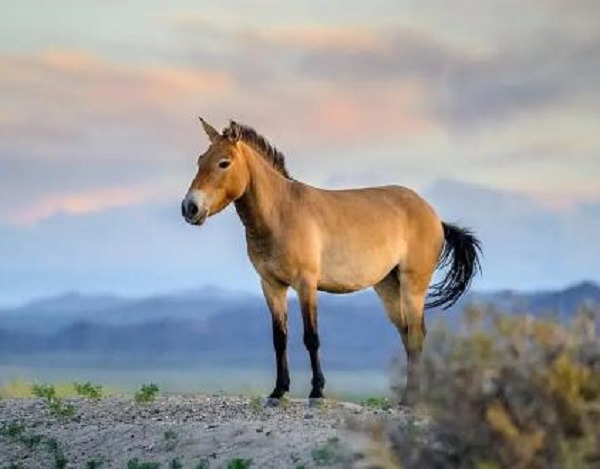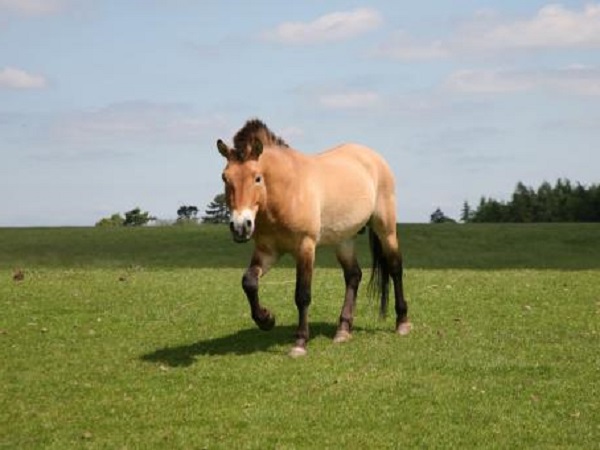Explore the captivating world of Przewalski’s Horse in our article, “Przewalski’s Horse: Exploring the Unique Traits of the Last Wild Equid Species.” These endangered equids from Central Asia, named after explorer Nikolai Przewalski, boast robust builds and distinct features. As the last wild horses with 66 chromosomes, their genetic uniqueness sparks debate. Join us to unravel their history, characteristics, and the vital conservation efforts preserving this ancient lineage.

An overview of the specifics of Przewalski’s horses
- COMMON NAME: Przewalski’s Horse
- SCIENTIFIC NAME: Equus ferus przewalskii
- TYPE: Mammals
- DIET: Herbivore
- GROUP NAME: Herd
- AVERAGE LIFE SPAN IN CAPTIVITY: 20 years
- SIZE: Shoulder height ranging from 48 to 56 inches
- WEIGHT: 440 to 750 pounds
History of Przewalski’s Horse
The history of Przewalski’s Horse unfolds through the lens of scientific discovery in the late 19th century, credited to Russian explorer N. M. Przewalski, after whom the horse is named. In that era, these magnificent creatures freely roamed the expansive steppe along the Mongolia-China border, embodying the untamed spirit of the region.
However, a significant chapter in their history unfolds as they vanished from the wild, prompting the initiation of captive breeding programs to ensure their survival. The species, having transitioned from the open steppe to controlled environments, has been safeguarded and propagated in captivity. A noteworthy milestone in their history is the recent reintroduction efforts in Mongolia, signaling a commendable endeavor to restore Przewalski’s horses to their native landscapes.
This journey, from free-roaming steppes to captivity and, most recently, to targeted reintroduction, encapsulates the nuanced history of Przewalski’s Horse — a tale of scientific discovery, conservation challenges, and ongoing efforts to preserve a species that once epitomized the untouched wilderness along the Mongolia-China border.
Characteristics of Przewalski’s horse

Przewalski’s Horse is unique in that it still exhibits wild and primitive characteristics in both appearance and behavior. These horses, in contrast to carefully developed domestic breeds, have a sturdy frame that has been sculpted by natural selection. Przewalski’s Horse is distinct from other equines in that it is a real representative of the wild horse lineage, with 66 chromosomes. Their behavior provides insight into the unique qualities that characterize this uncommon and amazing species, reflecting the wild spirit sculpted by survival instincts refined by natural selection.
Size and Appearance
Compared to horses raised domestically, Przewalski’s horses are physically different, with stockier bodies and shorter legs. They weigh between 550 and 800 pounds and are typically 12 to 14 hands tall. These horses stand out for having huge heads, broad necks, and straight manes devoid of forelocks. They have a distinct look due to primitive characteristics like leg stripes and a black dorsal stripe.
Most of Przewalski’s horses have dun coats with black manes, tails, and lower legs, with light patches known as pangarè or mealy markings on the belly, flanks, and nose. One characteristic that sets them apart are their lengthier hooves, which have noticeably thicker soles. Studies have shown that these horses’ foot horn stiffness varies with the season, indicating that this structural adaption is beneficial for maintaining the integrity of the hoof. Przewalski’s horses exhibit a range of morphological characteristics that have been carefully crafted by nature to ensure their survival in the wild.
Behaviour
Przewalski’s horses have unique behavior patterns; studies show that males are more active, which reflects their attention on defense and finding mates, much like in the wild. In order to get the energy required for breastfeeding and pregnancy, females prioritize foraging.
Time budget studies demonstrate that all of Przewalski’s horses grazed most of the time, exhibiting habits typical of domesticated horses. Aggression amongst members of the same social group is uncommon, although it happens more often the closer they are.
Przewalski’s horses are wild creatures that dislike intimate human contact; thus, in order to reduce stress and preserve their natural way of life, caregivers must take a hands-off attitude. Przewalski’s horses are kept in captivity using specialized approaches that minimize handling for necessary duties while maintaining their natural wild character. For example, zookeepers may teach horses to follow their natural tendencies by simplifying treatment by teaching them to set their feet on blocks for clipping instead of haltering them.
Diet of Przewalski’s Horses
Przewalski’s horses, like domestic ones, primarily graze on roughage, dedicating a significant portion of their time to foraging on various grasses and plants in their natural habitat. Before their extinction in the wild, research revealed their adaptability, shifting to a mixed browsing and grazing diet during winter when grass was scarce.
Historical competition with humans for pasture lands influenced their dietary habits, leading to adaptation to different food sources. Interestingly, reintroduced Przewalski’s horses, potentially influenced by captivity, exclusively consume grass and do not exhibit browsing behaviors observed in the wild. This highlights the impact of changing environments and human interactions on their dietary preferences.
Health problems of Przewalski’s horses
Reintroduced In the wild, Przewalski’s horses endure health issues and variable death rates due to a variety of circumstances. They get weaker due to common viral disorders in horses, including strangles, which leaves them vulnerable to predators, especially wolves. Their health issues are further exacerbated by tick-borne illnesses, trauma, fatigue, wasting, pneumonia, abortion, and stillbirth. As shown by a 26.6% death rate in a free-roaming population during a year of extreme cold and substantial snowfall, extreme weather conditions further increase dangers. In order to mitigate these health difficulties and maintain the resilience of Przewalski’s horses in their natural environment, the success of captive breeding operations is essential.
Organizational Social Structure
The organizational social structure of this species revolves around group dynamics, primarily composed of several mares, a dominant stallion, and their progeny. Occasionally, younger stallions may be found at the herd’s edges or form a separate bachelor group. Breeding privileges for these younger stallions hinge on their ability to triumph over the dominant stallion. As offspring mature and enter breeding age, they are expelled from the herd, reflecting a structured social organization that plays a crucial role in the species’ dynamics and reproduction.
Conclusion
Przewalski’s Horse, the last remaining wild equid species, encapsulates a tale of resilience, unique traits, and the ongoing struggle for conservation. As we explore their distinctive characteristics and behaviors, it becomes evident that the success of captive breeding programs is pivotal for their survival. With challenges in the wild and intricate social structures, the conservation efforts stand as a crucial endeavor to ensure the endurance of these remarkable wild horses.
